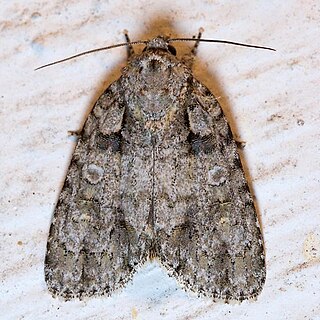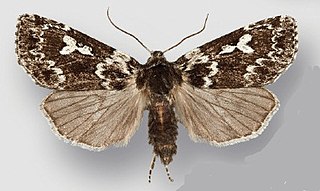
Acronicta increta, the raspberry bud dagger moth, raspberry bud moth or peach sword stripe night moth, is a moth of the family Noctuidae. The species was first described by Herbert Knowles Morrison in 1875. It is distributed throughout the south of Canada and the United States down to Florida and Texas.

Cirrhophanus is a genus of moths of the family Noctuidae. The genus was erected by Augustus Radcliffe Grote in 1872.

Euxoa is a genus of moths of the family Noctuidae raised to Genus by the German entomologist, Jacob Hübner. The Genus is mostly confined to dry and semi dry areas in the Northern Hemisphere. There 130 species in Eurasia, a few in Africa, and 175 in North America. There are no species in the Genus in South-East Asia or in Australia. In North America, most species are found in Western regions. Of the North American species, 4 are endemic to Mexico. There is one species recorded from Chile, but this may be a mislabeled specimen. In real terms, species numbers do not equal species abundance. Some areas with few species have large numbers of the ones that do live there.

Homophoberia is a genus of moths of the family Noctuidae. The genus was erected by Herbert Knowles Morrison in 1875.
Madeuplexia is a genus of moths of the family Noctuidae from Madagascar. The genus was erected by Pierre Viette in 1960.

Spragueia is a genus of moths of the family Noctuidae. The genus was erected by Augustus Radcliffe Grote in 1875.

Autographa californica, the alfalfa looper, is a moth of the family Noctuidae. The species was first described by Adolph Speyer in 1875. It is found in western North America from southern British Columbia to Baja California and to Manitoba, South Dakota, Colorado and New Mexico.

Agrotis stigmosa is a moth of the family Noctuidae first described by Herbert Knowles Morrison in 1875. It is found in North America from New England and Quebec west to Colorado and eastern Alberta. It is listed as a species of special concern in the US state of Connecticut.

Globia laeta, the red sedge borer, is a moth of the family Noctuidae. The species was first described by Herbert Knowles Morrison in 1875. It is found in North America, including Ohio, Illinois, New Jersey and Ontario.

Bulia deducta is a moth of the family Erebidae first described by Herbert Knowles Morrison in 1875. It is found from central Mexico north to central California, Utah, Wyoming and Nebraska, east to Arkansas and Alabama.
Caradrina meralis, the rare sand Quaker, is a moth of the family Noctuidae. The species was first described by Herbert Knowles Morrison in 1875. It is found in North America from New Jersey and New Hampshire, Ontario, Ohio and Wisconsin west across southern Canada to British Columbia, south to California and Arizona.

Schinia lucens, the leadplant flower moth or false indigo flower moth, is a moth of the family Noctuidae. The species was first described by Herbert Knowles Morrison in 1875. It is found in the central and western United States.

Xestia dilucida, the dull reddish dart or reddish heath dart, is a moth of the family Noctuidae. The species was first described by Herbert Knowles Morrison in 1875. It is found in the United States from southern Maine to northern Florida, west to central Ohio and eastern Texas.

Xestia perquiritata, the boomerang dart, is a moth of the family Noctuidae. The species was first described by Herbert Knowles Morrison in 1874. It is found across North America from Newfoundland, Labrador and northern New England, west to central Yukon, British Columbia and Washington. There are several disjunct populations, including one in the Great Smoky Mountains National Park and the Rocky Mountains in Colorado and a coastal bog in central Oregon.

Eutricopis nexilis, the white-spotted midget, is a moth of the family Noctuidae. The species was first described by Herbert Knowles Morrison in 1875. It is found in North America from Nova Scotia and New England west across southern Canada to southern Vancouver Island, north to Yukon and south in the mountains to California and Colorado.

Scopula cacuminaria, the frosted tan wave, is a moth of the family Geometridae. The species was first described by Herbert Knowles Morrison in 1874. It is found in North America across southern Canada, from the Maritimes to southern British Columbia, south to Texas.

Cirrhophanus triangulifer, the goldenrod stowaway or tickseed moth, is a moth of the family Noctuidae. The species was first described by Augustus Radcliffe Grote in 1872. It is found in the US from New York to Florida, west to Texas and Oklahoma, north to Wisconsin. In Canada, it has only been recorded from Ontario.

Stiriini is a tribe of owlet moths in the family Noctuidae. There are about 16 genera and more than 90 described species in Stiriini.

Sympistis riparia, the dune sympistis, is a moth of the family Noctuidae. The species was first described by Herbert Knowles Morrison in 1875. It is native to North America and it is listed as a species of special concern in Massachusetts and in Connecticut.

Cirrhophanus dyari is a moth in the family Noctuidae first described by Theodore Dru Alison Cockerell in 1899. It is found in North America.
















